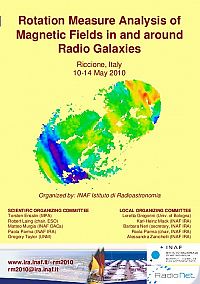›RM2010, Rotation Measure Analysis of Magnetic Fields in and around Radio Galaxies
Magnetic fields in groups and clusters of galaxies regulate thermal conduction and influence the dynamics of bubbles and cavities. In radio galaxies, they are essential to the production of synchrotron radiation and to most models for the collimation and acceleration of relativistic jets. Multifrequency radio polarization observations have recently led to important new results on foreground magnetic fields on parsec and kiloparsec scales. This area of research is about to take a major step forward with the commissioning of a new generation of instruments operating at centimetre and metre wavelengths: EVLA, e-MERLIN and LOFAR.
This specialised Workshop will focus on the analysis of multifrequency radio polarization imaging to derive magnetic fields in thermal plasmas along the line-of-sight to radio galaxies and quasars. Its aims are to take stock of the current state of the field, to compare different methods of analysis, to provide a forum for theorists and observers to interact and to prepare for observations with the new generation of arrays.
Topics will include:
- Algorithms for analysis of Faraday rotation data, including rotation-measure synthesis.
- Approaches to measuring the spatial statistics of rotation-measure fluctuations, such as structure functions and Bayesian methods.
- Magnetic fields in individual elliptical galaxies, groups and clusters; trends and differences.
- Coherent RM structures and their implications.
- Theory of magnetic-field generation and evolution in groups and clusters.
- The effects of interaction of radio galaxies with the surrounding medium.
- Implications for heating and cooling of groups and clusters.
- Observations of Faraday rotation on parsec scales.
- Theoretical models; implications for jet formation and collimation.
Track this event on your Apple calendar














 Italy
Italy